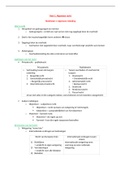Summary
Marketing for Pre-master Summary Midterm 2 Chapter 7 to 14
- Course
- Institution
- Book
A summary of the book Hoyer/MacInnis/Pieters' Consumer Behavior, 8th Edition which is required to study for the course Marketing for pre-master when following the pre master Marketing Management at Tilburg University. The chapters 7 until 14 are summarised which are required to know for the second ...
[Show more]













